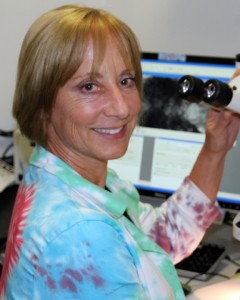Ocorr Ph.D. ’83: Fruit Flies on Space Mission for Research

Karen Ocorr Ph.D. ’83 is sending fruit flies into space to study their heart development and function outside of Earth’s gravity. An assistant research professor in the Development and Aging Program at the Sanford-Burham Medical Research Institute, Ocorr is collaborating with fellow researchers at NASA Ames Research Center and Stanford University to study the effects of space travel and microgravity on the heart function of fruit flies.
“We believe that our studies with fruit flies can provide us with important information that will impact astronauts’ heart health when they spend extended periods in microgravity including current missions aboard the ISS (International Space Station) and future manned missions to Mars,” Ocorr said.
In December 2013, the fruit flies will be flown to the International Space Station for approximately 30 days, with identical ground controls. Post-flight both will be analyzed for alterations in heart function, using a system developed by Ocorr and Rolf Bodmer, Ph.D. at Sanford-Burham.
When Ocorr first began presenting her research idea to cardiologists, she met with skepticism and confusion; no one seemed to see the possible connection to human hearts. While fruit fly hearts are clearly much smaller than human hearts, they have several important similarities. For example, they use many of the same ion channels involved in causing the contractions of the heart, making them a better model in this respect than mouse hearts, which beat far faster than human hearts, using different cellular components. Rolf Bodmer was one of the first to see the useful connection between fruit fly and human hearts: In the 1990s, he discovered a gene in fruit flies called “tinman” that, when mutated, caused the fruit fly to not have a heart. In humans, that same gene nkx2.5, in concert with several other genes, turned out to also be critical for embryonic heart development. In 2004, Ocorr took this discovery a step further, noting—as a result of discovering a mutant fly with heart arrhythmia—the similarities in the cellular function of the heart in both fruit flies and humans.
The short life span of fruit flies is also an asset in this space research project, she noted. Researchers can study the effects of living 80 percent of a life in space in only a month with fruit flies, whereas with humans it would, of course, take decades. Ocorr describes the main experiment for an article in Orlando Medical News as “…a look at heart function and atrophy in flies that have been in space for a while… We’ll send up our normal flies and also the mutant flies that are predisposed to heart malfunction and we’ll see the differences in ways these different types of flies can cope with microgravity.”
When asked by Orlando Medical News if she’d like to accompany the flies on their space mission, Ocorr replied, “In a heartbeat; no pun intended.”

